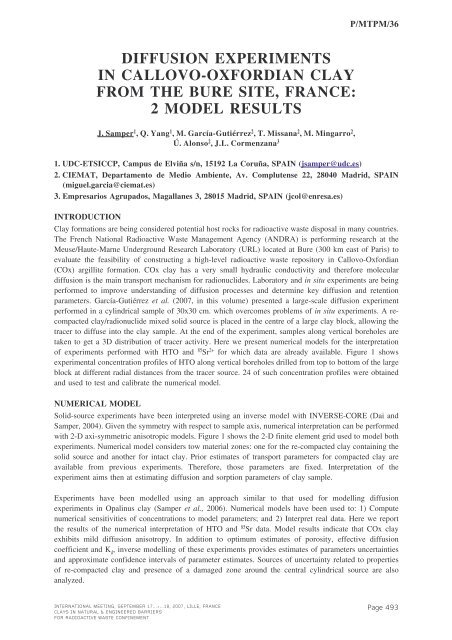Mass Transfer & Porous Media (MTPM) - Andra
Mass Transfer & Porous Media (MTPM) - Andra
Mass Transfer & Porous Media (MTPM) - Andra
You also want an ePaper? Increase the reach of your titles
YUMPU automatically turns print PDFs into web optimized ePapers that Google loves.
P/<strong>MTPM</strong>/36DIFFUSION EXPERIMENTSIN CALLOVO-OXFORDIAN CLAYFROM THE BURE SITE, FRANCE:2 MODEL RESULTSJ. Samper 1 , Q. Yang 1 , M. García-Gutiérrez 2 , T. Missana 2 , M. Mingarro 2 ,Ú. Alonso 2 , J.L. Cormenzana 31. UDC-ETSICCP, Campus de Elviña s/n, 15192 La Coruña, SPAIN ( jsamper@udc.es )2. CIEMAT, Departamento de Medio Ambiente, Av. Complutense 22, 28040 Madrid, SPAIN(miguel.garcia@ciemat.es)3 . Empresarios Agrupados, Magallanes 3, 28015 Madrid, SPAIN (jcol@enresa.es)INTRODUCTIONClay formations are being considered potential host rocks for radioactive waste disposal in many countries.The French National Radioactive Waste Management Agency (ANDRA) is performing research at theMeuse/Haute-Marne Underground Research Laboratory (URL) located at Bure (300 km east of Paris) toevaluate the feasibility of constructing a high-level radioactive waste repository in Callovo-Oxfordian(COx) argillite formation. COx clay has a very small hydraulic conductivity and therefore moleculardiffusion is the main transport mechanism for radionuclides. Laboratory and in situ experiments are beingperformed to improve understanding of diffusion processes and determine key diffusion and retentionparameters. García-Gutiérrez et al. (2007, in this volume) presented a large-scale diffusion experimentperformed in a cylindrical sample of 30x30 cm. which overcomes problems of in situ experiments. A recompactedclay/radionuclide mixed solid source is placed in the centre of a large clay block, allowing thetracer to diffuse into the clay sample. At the end of the experiment, samples along vertical boreholes aretaken to get a 3D distribution of tracer activity. Here we present numerical models for the interpretationof experiments performed with HTO and 85 Sr 2+ for which data are already available. Figure 1 showsexperimental concentration profiles of HTO along vertical boreholes drilled from top to bottom of the largeblock at different radial distances from the tracer source. 24 of such concentration profiles were obtainedand used to test and calibrate the numerical model.NUMERICAL MODELSolid-source experiments have been interpreted using an inverse model with INVERSE-CORE (Dai andSamper, 2004). Given the symmetry with respect to sample axis, numerical interpretation can be performedwith 2-D axi-symmetric anisotropic models. Figure 1 shows the 2-D finite element grid used to model bothexperiments. Numerical model considers tow material zones: one for the re-compacted clay containing thesolid source and another for intact clay. Prior estimates of transport parameters for compacted clay areavailable from previous experiments. Therefore, those parameters are fixed. Interpretation of theexperiment aims then at estimating diffusion and sorption parameters of clay sample.Experiments have been modelled using an approach similar to that used for modelling diffusionexperiments in Opalinus clay (Samper et al., 2006). Numerical models have been used to: 1) Computenumerical sensitivities of concentrations to model parameters; and 2) Interpret real data. Here we reportthe results of the numerical interpretation of HTO and 85 Sr data. Model results indicate that COx clayexhibits mild diffusion anisotropy. In addition to optimum estimates of porosity, effective diffusioncoefficient and K d , inverse modelling of these experiments provides estimates of parameters uncertaintiesand approximate confidence intervals of parameter estimates. Sources of uncertainty related to propertiesof re-compacted clay and presence of a damaged zone around the central cylindrical source are alsoanalyzed.INTERNATIONAL MEETING, SEPTEMBER 17...>...18, 2007, LILLE, FRANCECLAYS IN NATURAL & ENGINEERED BARRIERSFOR RADIOACTIVE WASTE CONFINEMENTPage 493
















